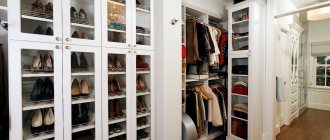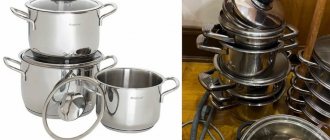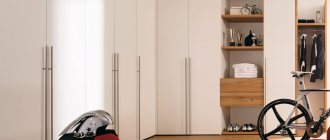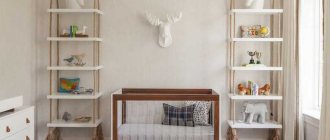Closet storage
A full-fledged design with hinged doors or a wardrobe with many compartments is quite spacious furniture, which is suitable not only for storing seasonal shoes, but also for a complete family wardrobe.
The photo shows an option for storing shoes in a closet with transparent glass fronts.
Roll-out cabinets in the form of a narrow or low design will fit perfectly into a small hallway. Small models allow you to store shoes compactly and do not take up much space.
How to properly store shoes
There are no specific rules for storing shoes. The main thing is to make sure that the shoes do not deteriorate while they are lying there. At the same time, remember about your own comfort and convenience - it should not interfere. Here are some tips for storing shoes properly.
Find a place that is dry and away from sunlight. It should also not collect a lot of dust. These factors significantly affect shoes and, under their influence, they quickly lose their appearance and practicality - the material cracks, colors fade.
In such a place there must be a stable temperature regime. A place that is too cold or warm (less than 15 or more than 25 degrees) will ruin the appearance of the products.
Ensure constant air circulation. If the humidity in the room is high, mold may appear.
Don't forget about the moth. She can ruin a pair of shoes in one season. To prevent this from happening, treat your pair with a protective agent. Special balls (which are found in shoe boxes) and the oil of certain plants (for example, citrus fruits) help well against pests. If you do everything correctly, your boots or shoes will not deteriorate even after several years of continuous storage.
Shoe shelves
Shoe shelves are an almost necessary element for the interior of any apartment or house, since this device provides a very neat organization of shoe storage.
There are a huge variety of different single-tier, multi-tier, floor-standing and hanging models. The main advantage of open horizontal or vertical structures is their large capacity.
The photo shows the interior of a dressing room with open shelves and shelves for storing shoes.
Retractable or folding shelves look very elegant in the interior. Such closed systems meet all storage conditions. They perfectly protect shoes from dirt, dust and sunlight.
Basic storage rules
The storage conditions of shoes significantly affect their properties, appearance, and durability. Its safety depends on many factors: exposure to sunlight, dust, humidity, room temperature, installation method, protection from moths and rodents. Having decided to organize a special maintenance system in your own home, you should adhere to certain rules:
- Initially, you should collect all the shoes, wash them, clean them of dirt, and dry them.
- The next step is to sort the items by season. It is necessary to separate spring, winter, summer, autumn models.
- Each pair must be carefully inspected. If defects are found, they will need to be corrected. If necessary, repair, glue the sole, replace the heel, insert the insole.
- Products that cannot be repaired should be disposed of. This step will save space and not clutter it with useless junk.
- To avoid deformation, delamination, and cracks, you need to straighten things out, put pads, paper, and plastic bottles inside.
- It is recommended to treat surfaces with softening cream and special substances appropriate for the material. This will prevent drying out and loss of shine.
- An important step is choosing a location. It should be dark, dry, and have good ventilation. Sunlight can lead to fading, high humidity can lead to the appearance of mold and mildew. It is also worth taking care of the distance from heating devices to avoid things from drying out.
- Perform zoning of space. Make room for men's, women's, and children's models. Provide for seasonal division.
- The ideal option would be to use a separate box for each pair.
All kinds of organizers
Basically, organizers are convenient fabric products that fasten with a zipper. This functional element has reinforced cardboard walls to maintain its shape and a transparent top that allows you to see the internal contents. Thanks to this, you won’t have to waste time searching for the right shoes or boots.
There are floor-mounted and wall-mounted models. A hanging door organizer is perfect for small spaces. Such a compact product with roomy pockets can easily be placed on the door leaf in the hallway or in the dressing room. However, please note that you cannot put dirty shoes in organizers.
The photo shows a compact fabric organizer for storing shoes.
Lighting in the dressing room
According to the rules, the dressing room must be illuminated by at least one window. This saves energy and allows you to find things without the light on.
Lighting planning begins with dividing the wardrobe into zones.
The first zone includes a section 150 cm high with outerwear, the second contains short clothes and is 100 cm high, the third zone is for shoes. Where there will be a fitting room, a full-length mirror is needed.
Places with mirrors require separate lamps around them. After all, the fitting place is the most important, where a person looks at himself and evaluates his appearance.
The main task is to choose lighting that will be bright, but not cause eye strain.
Using different light sources in the dressing room
If the room has suspended ceilings, it is recommended to use built-in devices with a wide dispersion angle. For ordinary ceilings, chandeliers and ordinary lamps are used. The most convenient are rotating lamps that you can direct yourself.
Rules for choosing lighting:
- You should choose economical lamps.
- The lighting is as natural as possible.
- There is no need to choose lamps that are too bright.
- Lighting should be planned before installing cabinets and shelving.
- If the wardrobe is small, you should not illuminate the mirror.
It is logical to arrange all seasonal shoes in the dressing room on convenient racks or open shelves
Boxes and boxes
For organized storage by season or sorting shoes for each family member, use transparent boxes, which not only provide a quick search for the right pair, but also make the room functional and very stylish. Such products can be located in a closet or on open shelves.
No less original and convenient are plastic boxes made of polypropylene, which does not emit unpleasant odors. These systems are sufficiently thick and do not deform under the weight of footwear. Most boxes are equipped with special openings for high-quality ventilation.
The photo shows a method for storing shoes in a cardboard box.
An unusual solution for storing shoes would be wooden boxes that can be painted, varnished and fixed in the desired order on the wall. Wicker models made of rattan or wicker are distinguished by easy cleaning and high moisture-resistant qualities.
Boxes and crates are quite compact and mobile. Therefore, they can be laid out even on mezzanines.
Shoe storage: preparation
Even if you follow all the rules of dryness, temperature and other factors, each pair of shoes needs to be prepared before leaving them for a season or several. If this is not done, then there is a chance that couples will not “survive” until the next period. To prepare, do the following:
- Clean the surface of your boots or shoes from dust. Use a dry cloth or napkin.
- Wipe your shoes with a damp (but not wet) sponge.
- Remove the insoles from your shoes if possible.
- Before you stash your pairs in your closet, closet, or other space, dry your shoes well at room temperature to remove excess moisture. Do this at room temperature, as near a fireplace or radiator, the material will deteriorate due to dryness and high temperature.
- Put special spacers or lasts into each pair of shoes. If you don't have them, you can use regular newspaper rolls. They take away all remaining moisture and help maintain the original shape of the products. If this is not done, then when you take out the shoes, you may find that they have become wrinkled or even decreased in size.
- Treat each pair of boots with a special composition - this can be a cream or spray for leather, suede, etc.
- Place your shoes in a box or fabric bag. This will help maintain the same temperature inside for several months, protect from the sun and excess light, and also prevent dust from settling. Under no circumstances should shoes be stored in plastic bags - they impede air circulation and disrupt the microclimate.
You need to prepare shoes for storage in exactly this order, regardless of whether they stand without a box or lie in one.
Shoe racks
Oversized storage system equipped with horizontal shelves. Shelving structures are mainly installed in a spacious hallway, in a separate storage room, dressing room or in a niche.
Open shelving allows you to neatly store shoes neatly arranged in a row. Such models are well suited for children's shoes, as everything is at hand and provides an excellent overview.
The photo shows tall shoe racks in the interior of a dressing room.
Shoe racks
Manufacturers have long been racking their brains over the optimal way to store furniture and have achieved some success. Just look at the variety of shoe racks that allow you to place your shoes compactly and attractively. You can make analogues of such racks yourself: for example, it is convenient to store boots on hangers with clips.
Suspension systems
It would be appropriate to put small soft shoes in the hanging pockets. These models have a flat design, which allows you to significantly save space. Pockets are sometimes decorated in an original way and turn them into an unusual decoration of the entire interior.
The photo shows storing shoes in fabric hanging items inside the wardrobe.
Closed shoe cabinet
If earlier apartments had simple shelves at the entrance, now there is a flat shoe cabinet in the hallway, where your shoes are securely hidden from all eyes.
Shoes in a modern closet are arranged vertically, which saves space. You can choose a shoe cabinet with 2-3-4 compartments. A two-tier shelf for 10-12 pairs is another common “quick wardrobe” configuration for shoes, boots, and sneakers. They are usually made of plastic or metal, making them easy to keep clean. You can also purchase a miniature cabinet with hinged doors.
Hidden storage systems
Hidden storage space makes the surrounding space much more aesthetically pleasing, keeps the room tidy and solves the problem of saving usable space.
In the interior of the home, numerous shoe items can be stored in cabinets under the stairwell or in hidden pull-out shelves in the steps. This solution is suitable not only for storing shoes, but also for seasonal items or other necessary little things.
The photo shows a roll-out tray for storing shoes under the bed.
It would also be appropriate to use the space under the bed. Shoes can be stored in special wooden pallets, transparent containers or organizers.
How to prepare shoes for storage
Before putting sandals, sneakers or winter boots in the closet, you need to first prepare them for a period of long storage:
- First of all, shoes and boots need to be cleaned and washed. The soles are washed under warm water, the uppers are carefully cleaned with a damp cloth, and then wiped dry or the shoes are allowed to dry naturally. Sneakers and sneakers can be washed before winter storage, the insoles are removed and also washed or simply thrown away.
- Completely dried shoes are carefully inspected. If boots or shoes require repairs, then it is necessary to repair the heel, clasp or change the heels before putting the items in the closet.
- Clean and restored shoes are treated from the inside with a special antiseptic spray; it will prevent the appearance of mold or mildew, and will also prevent the formation of an unpleasant odor.
- To prevent shoes from losing their shape, the inside is tightly stuffed with crumpled paper or newspapers. You can also insert special lasts from a shoe store into boots or boots, which will help prevent deformation of the products.
- Before storing leather shoes, they should be cleaned using a special cream; it will soften the material and prevent it from drying out over several months of rest. It is recommended to put a special moth repellent in fur winter boots and boots.
Completely prepared products can be stored. If you spend a little time on each of the listed stages, then in the new season your boots and shoes will still look attractive, and you can put them on right away, without prior preparation or repairs.
Before storing boots, they need to be washed and treated with cream.
Ottomans
A compact and neat pouf with a special folding seat not only allows you to store summer shoes or winter boots, but also provides the most comfortable process for changing shoes. In addition, the ottoman, due to its specific stylistic design and upholstery made of different materials, becomes a bright accent of the entire interior.
Multifunctional bench chests or structures in the form of sofas and banquettes fit perfectly into the design of any corridor. Many designs are equipped with containers or textile covers with cells.
The photo shows an ottoman equipped with textile cells for storing shoes and boots.
Proper shoe storage
Even after you have put all your pairs of shoes in their places, they will need to be looked after periodically. Thanks to this, the shoes will last longer and remain in their original form.
At least once a month, take your shoes or boots off the shelves to check their condition. Wipe off accumulated dust, treat them with cream and make sure that there are no moths in the closet or wardrobe. If everything is fine with the shoes, then simply put them back in their place. If you see that something is wrong with it, then think about where else it can be stored.
You need to check your shoes at least once a month, but you shouldn’t rub them every day. The main thing is regularity and thoroughness.
You should not store several pairs of different shoes in one bag, container or box - they will stain each other. Don't forget that different materials require different care - suede boots are more finicky than leather ones, etc.
If there is something wrong with the shoes and they need minor repairs, then it is better to do it before you start putting them in the closet. If boots or shoes have severe scuffs, they may increase while they are stored. To avoid this, take them to the specialist in a timely manner. Another advantage of pre-repairing is that in the event of a sudden cold spell or bad weather, you can immediately use boots or boots.
Baskets and buckets
For a hallway or dressing room in Provence or classic style, shoes can be stored in eco-friendly wicker baskets. Similar products, distinguished by high decorative properties, are placed under a bench or placed on shelves.
The photo shows wicker shoe baskets located under the bench in the hallway interior.
An interesting idea for storing shoes would be to use bright buckets. In these containers, intended for completely different purposes, you can store compact shoes.
Any closet is like a shoe closet
Shoe storage can be made original by using a vintage cupboard or glass rack for this purpose. It’s good if it has a closed lower part and open shelves on top - then the prettiest shoes can be displayed on the shelves, let them serve as decoration, and felt boots or old sneakers can be hidden behind opaque doors.
Hangers, clothespins, hooks
In order to store high-top boots, hangers with two clothespins are used, which can be hung on a bar in the closet. Thanks to this life hack, creases will not appear on the shoes and they will retain their original appearance for a long time.
The photo shows the design of a wall in the hallway equipped with hooks for shoes.
Children's and men's lace-up shoes or high-heeled shoes can be stored on hooks on the wall. Shoes hung with laces tied with a bow will look original.
The photo shows special hangers for storing boots.
Dressing room and pantry: the best way to organize storage
In a large house, you can allocate a separate room for storing things. A walk-in closet is the perfect place to store all your shoes. Here you can provide special structures for placing items in sections. Properly organize a system for arranging everyday and seasonal shoes, and allocate a separate place for women's and men's models.
Owners of small apartments are less fortunate in this regard. But even in this case, do not despair. You can organize a dressing room in place of the pantry. For this, a room of 1 x 1.5 m is enough. It is necessary to take into account that the pantry is a closed space, so you will have to equip a forced ventilation system and choose the right lighting. After which you can place cabinets, bedside tables, racks, and shoe racks.
If for some reason it is not possible to convert the pantry, then you will have to look for alternative options. For example, in the summer, you can use a glazed balcony or loggia for these purposes. It is also worth thinking about the rational use of walls in the hallway or bedroom, equipping a special niche, and considering options for using pieces of furniture and the free space under them.
Cornices
You can use a curtain rod with curtain rings to store bright shoes and boots in an unusual way. Thanks to this creative approach, the interior acquires an individual look.
Shoes hung on mounts on the ledge are always within easy reach and allow you to free up useful space in the dressing room or hallway.
Special shoe cabinet
This closet is a closed storage with special shelves: the shoes in them stand vertically, so even if you put dirty shoes there, all the dirt will flow into the groove, which you then simply need to rinse.
When purchasing a cabinet, pay attention to the height of the shelves. Some overshoes can only accommodate sneakers/shoes/boots, but full-height high boots will not fit. Most likely, it will be more rational to store them separately than to waste useful cabinet space under a double-height shelf.
Original homemade devices
An old stepladder or ladder will serve as a shoe rack. The structure is decorated and fixed to make it more stable. Shoes and boots can be stored on the steps, and the rungs can be supplemented with hooks for hats and other accessories.
The remains of PVC water pipes represent a budget-friendly, but at the same time original shoe storage. The independent process of creating such a system does not take much time.
For indoor slippers or ballet shoes, it is appropriate to mount several aluminum jars on the wall. Such products have a neat, stylish and less bulky appearance, unlike plastic pipes. This design will fit perfectly into a small corridor in an industrial loft style.
The photo shows the idea of storing shoes in plastic pipes.
A simple metal lattice on which you can store shoes by hanging them by the heel will look impressive in the interior. In order to construct a shelf, scraps of pipes or an old battery are suitable.
Designs in the form of a shoe rack made from ordinary boxes, wire baskets, wooden packing boxes or a compact cardboard rack will help you organize storage correctly.
Sneakers and sneakers can be stored on shelves made of skateboards, and a memorable pair of shoes, such as a wedding, can be covered with an elegant glass cover and made the central decoration of the dressing room.
How to transport shoes
If you are going to transport shoes, it is best to do this in hard cardboard or plastic boxes - this way you will be sure that they will not get knocked down or deteriorate during transfer. When transporting, do not put several pairs of shoes in one container. It is advisable that the shoes are tightly fixed; for this, you can put newspapers in the box.
Selection of storage accessories
As a useful accessory, a stand for shoes and boots is used, which is designed for two pairs at once. This method of storing shoes allows you to save useful space inside the closet or on the shelves.
The photo shows a plastic stand for storing two pairs of shoes.
In order to store shoes without boxes, you can purchase or sew bags made of thick but breathable fabric yourself.
Instead of using bulky boxes and containers, a pair of shoes is simply held together with an elastic band and packaged in airtight organizers that can be hidden under the bed or placed on the loggia.
The photo shows storing shoes in multi-colored sealed bags.
Where should you not store shoes?
It is not recommended to store shoes on the balcony, as there are constant temperature changes, too humid or, conversely, dry. Shoes on the balcony will deteriorate in one or two seasons and will be unsuitable for further wear.
You should not put your shoes in the hallway - they will constantly get under your feet and disturb all family members.
Stage 4: preparation for use
After proper storage, shoes need to be prepared for use. Having taken it out of the box, you need to make sure that it has a decent appearance and, if necessary, perform cosmetic care. In addition, shoes are stored in dry conditions, so before use it is necessary to slightly moisten them naturally.
To do this, you need to unpack it a few days before the first use, remove all improvised drying systems and place it in the hallway. After standing like this for several days, the boots will gain the necessary level of moisture and will be ready for everyday wear without compromising their integrity and your health.
Let's summarize the sequence of actions necessary for proper storage of winter shoes:
- Clean and wash thoroughly.
- Dry completely using a special system or using various ideas for using available products.
- If there is damage, repair the house or take it for repairs.
- Treat with special antiseptic agents.
- Seal the shoes from the inside so that they do not wrinkle.
- Place in an organizer, drawer or other storage device.
- Perform minimal maintenance periodically.
- Prepare before use.
The rules discussed may seem frivolous to some, but careful adherence to them will keep winter shoes in good condition for several seasons. This will free up space in the apartment, no special furniture will be required, and it will always be convenient to gather in the hallway or hallway. If stored incorrectly, wardrobe items deteriorate much more than when used.
White chest of drawers with four compartments for storing shoes
White bench for the hallway with storage compartments for shoes
You can make “hangers” for storing shoes from wire. Large cabinet with glass shelves for shoes. Ottoman with pockets for shoes.
Pull-out shoe shelf
Shoe organizer
We've covered all aspects of storing winter boots, now it's time to touch on a special device for this purpose. A shoe organizer is a large module for storing shoes, divided into sections (usually 6), which you can buy or make yourself. The beauty of making it yourself is the ability to realize the bold design ideas that may come to mind.
Functionally, it is a large trunk made of thick fabric, fastened with a zipper. You can put shoes and other wardrobe items in separate sections. The walls are padded with cardboard to help maintain their shape, and the tops of the organizers are usually transparent so you can quickly see what's where. When such an organizer is no longer needed, it folds up perfectly and takes up less space than a small bag.
Using an organizer or any other case for storing shoes, you will not only ensure the safety of your shoes, but also make your life easier, since you will know exactly where the shoes you need at that moment are.
Large trunk for storing shoes can be placed in a closet Hanging organizer for clothes and shoes
Transparent shoe organizer for closet door
Clear Shoe Boxes Small Shoe Organizer with Clear Top White Closet with Rotating Shoe Shelves











